| dc.contributor.author | Soita, Musirnbi | |
| dc.date.accessioned | 2013-05-25T11:39:06Z | |
| dc.date.issued | 2010 | |
| dc.identifier.citation | Masters of medicine in Obstetrics and gynecology, Nairobi University, 2010 | en |
| dc.identifier.uri | http://erepository.uonbi.ac.ke:8080/xmlui/handle/11295/25728 | |
| dc.description.abstract | Objective; To determine the Maternal and Fetal outcomes in terms of Maternal and
Fetal morbidity and mortality in mothers presenting with obstructed labour compared
to other parturients undergoing emergency caesarian section at PGH Kakamega.
Ratianale; Obstructed labour is a major cause of maternal and perinatal morbidity and
mortality accounting for an estimated 8% of maternal deaths [4]. This is an entirely preventable labour complication with improvement in comprehensive antenatal care, good and timely referral system and timely intervention (4)
There is limited data an studies in our set up that have been objectively done to
determine the maternal and fetal outcomes of mothers with obstructed labour.
Methodology; This was hospital based prospective cohort study .The study area was
PGH Kakamega Obstetric unit. The study was conducted between August 2008 and
January 2009. The study group comprised of 135 mothers with obstructed labour while
the comparison group also comprised of 135 mothers. Data collected was analyzed in
SPSS version 15.0. Data analysis entailed the use of descriptive statistics such as
frequency distributions and cross tabulations using the chi-square statistics.
Results; The study found that the prevalence of obstructed labour was 6.8%. Women
with obstructed labour had low educational and socioeconomic status compared to the
comparison group (p 0.032, 0.05). While 90% of mothers with obstructed labour had
attended antenatal clinic only 49% had indented to deliver in hospital. Factors that
contributed to the delay in presenting to hospital included; lack of funds (27%), husband
or mother in-law refusal to give consent for hospital delivery (26%), lack of transport or
ambulance at the primary and secondary level facility (17%). Obstructed labour was
associated with significant maternal morbidities; ruptured uterus 6%, obstetric
hysterectomy 5.2 %( p 0. 0015), uterine tears 14.8% (p 0.000), postpartum hemorrhage
14.9% (p 0.000), wound sepsis 43% (p 0.0001) and puerperal sepsis 26.7% (0.000).
Obstructed labour was also associated with significant fetal mortality and morbidities; stillborns 18.5% (p 0.0001), low Apgar score 30%, newborn unit admission 26.6% (p 0.0001) and neonatal sepsis 16.5% (p 0.0001).
Conclusion; There is need to improve the educational and socio-economic status of the
women. Restructuring of M.C.H. Services should be done with particular attention to
increasing community awareness on safe obstetric care, quality health talks to our
antenatal clients on safe obstetric care, establishing a streamlined and effective referral
system at the primary and secondary health care facilities and partnership with the
community on the importance of safe obstetric care. | en |
| dc.language.iso | en | en |
| dc.publisher | Univesity Of Nairobi | en |
| dc.title | Fetal and Maternal outcomes of mothers presenting with Obstructed labour at Provincial General Hospital Kakamega | en |
| dc.type | Thesis | en |
| dc.description.department | a
Department of Psychiatry, University of Nairobi, ; bDepartment of Mental Health, School of Medicine,
Moi University, Eldoret, Kenya | |
| local.publisher | Department of Obstetrics and Gynaecology,University of Nairobi | en |

